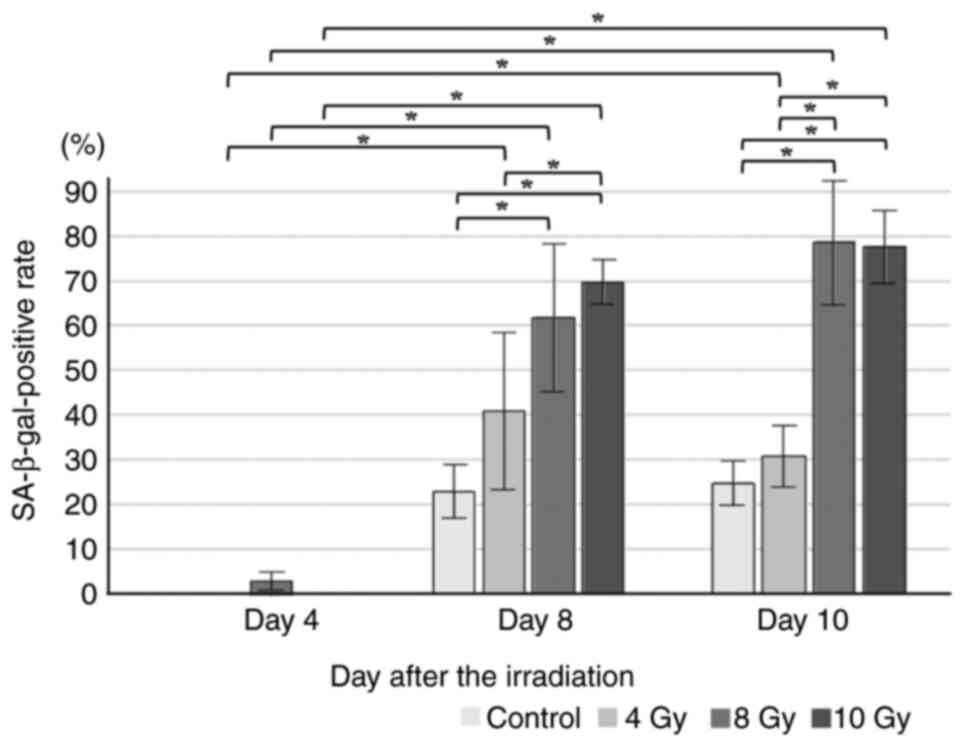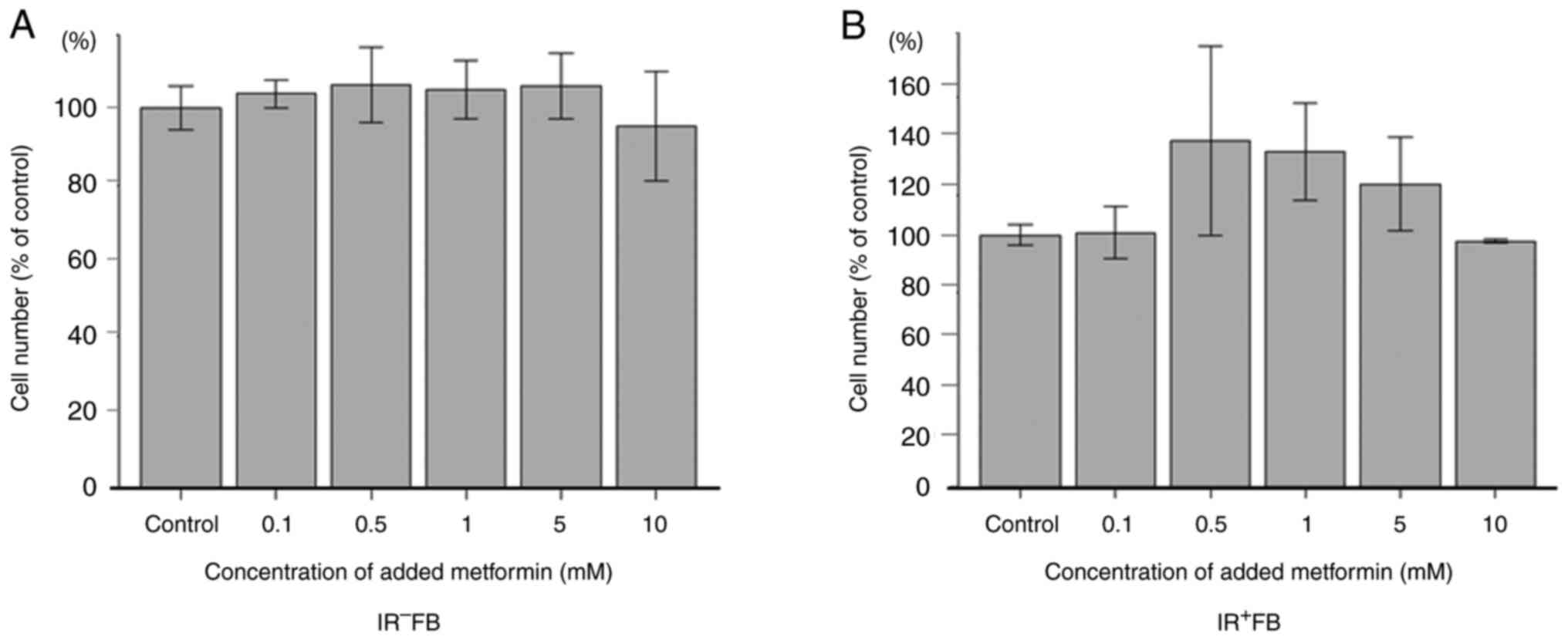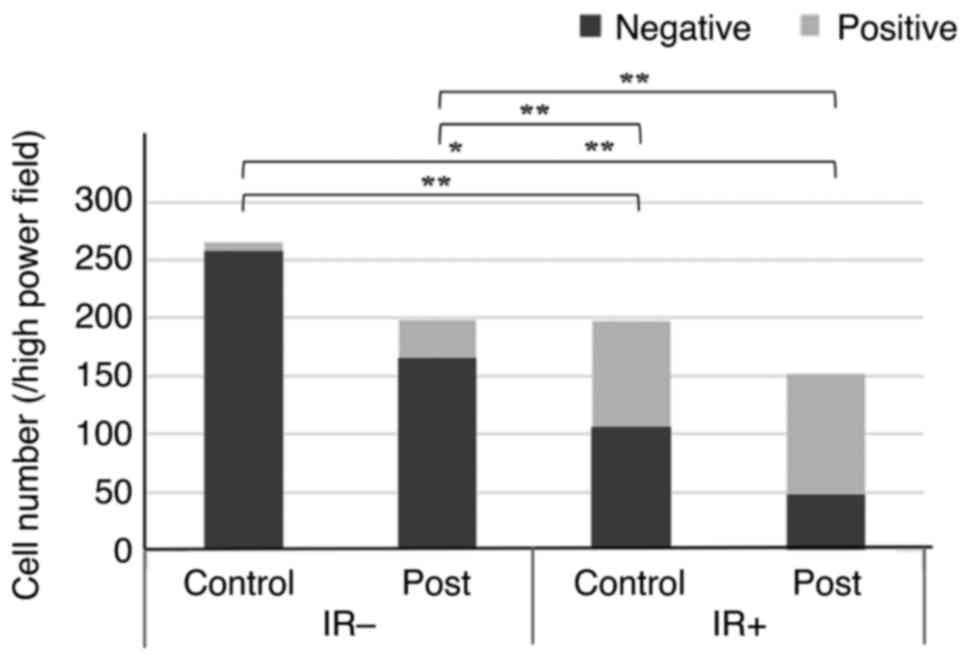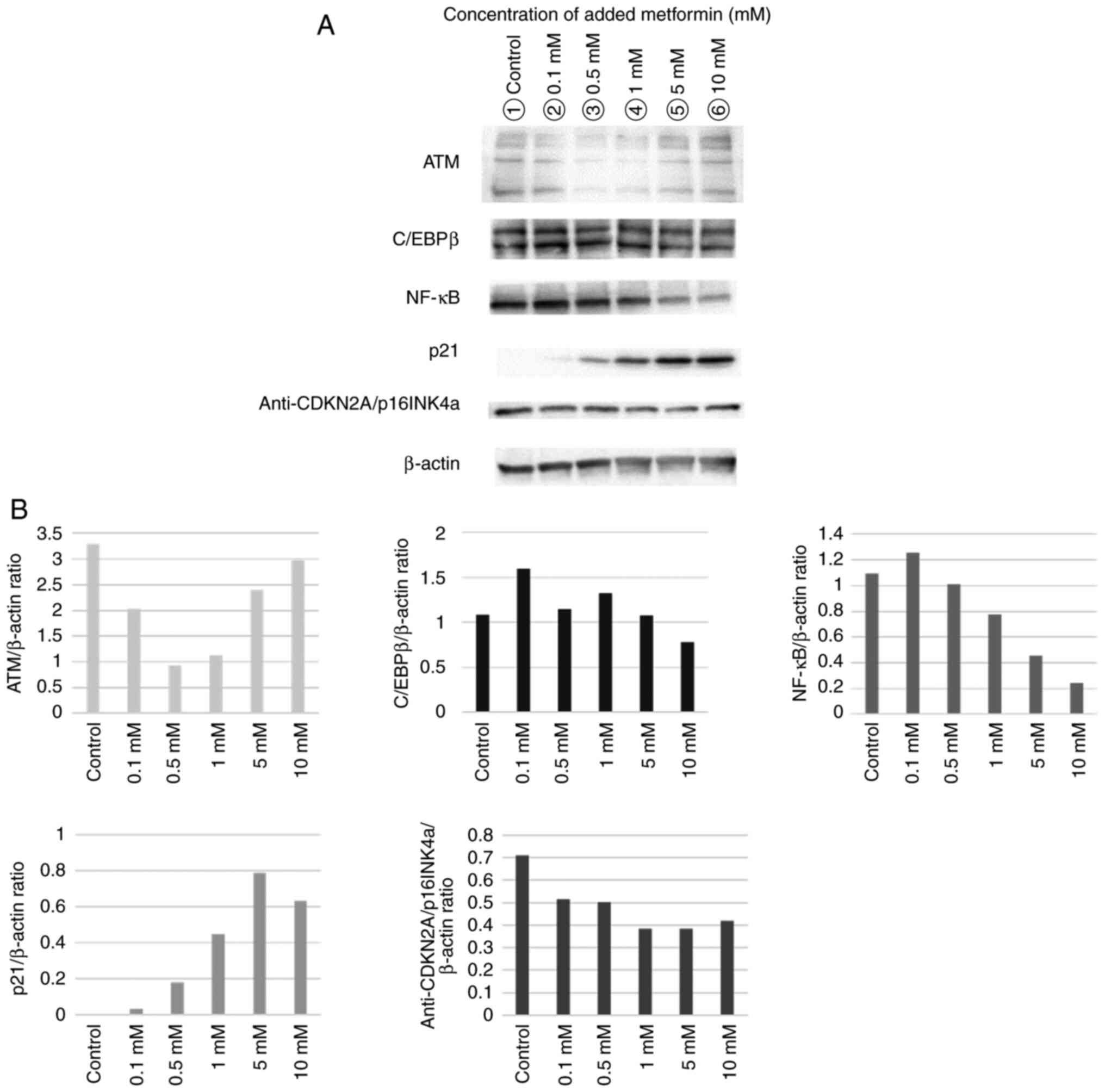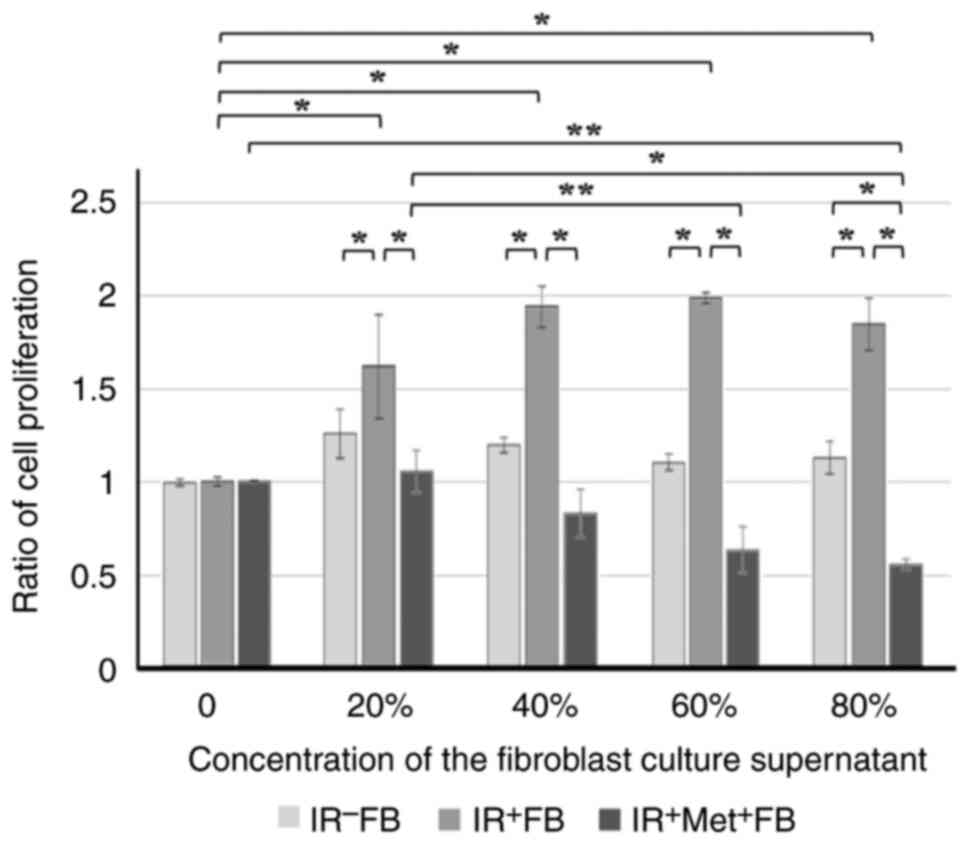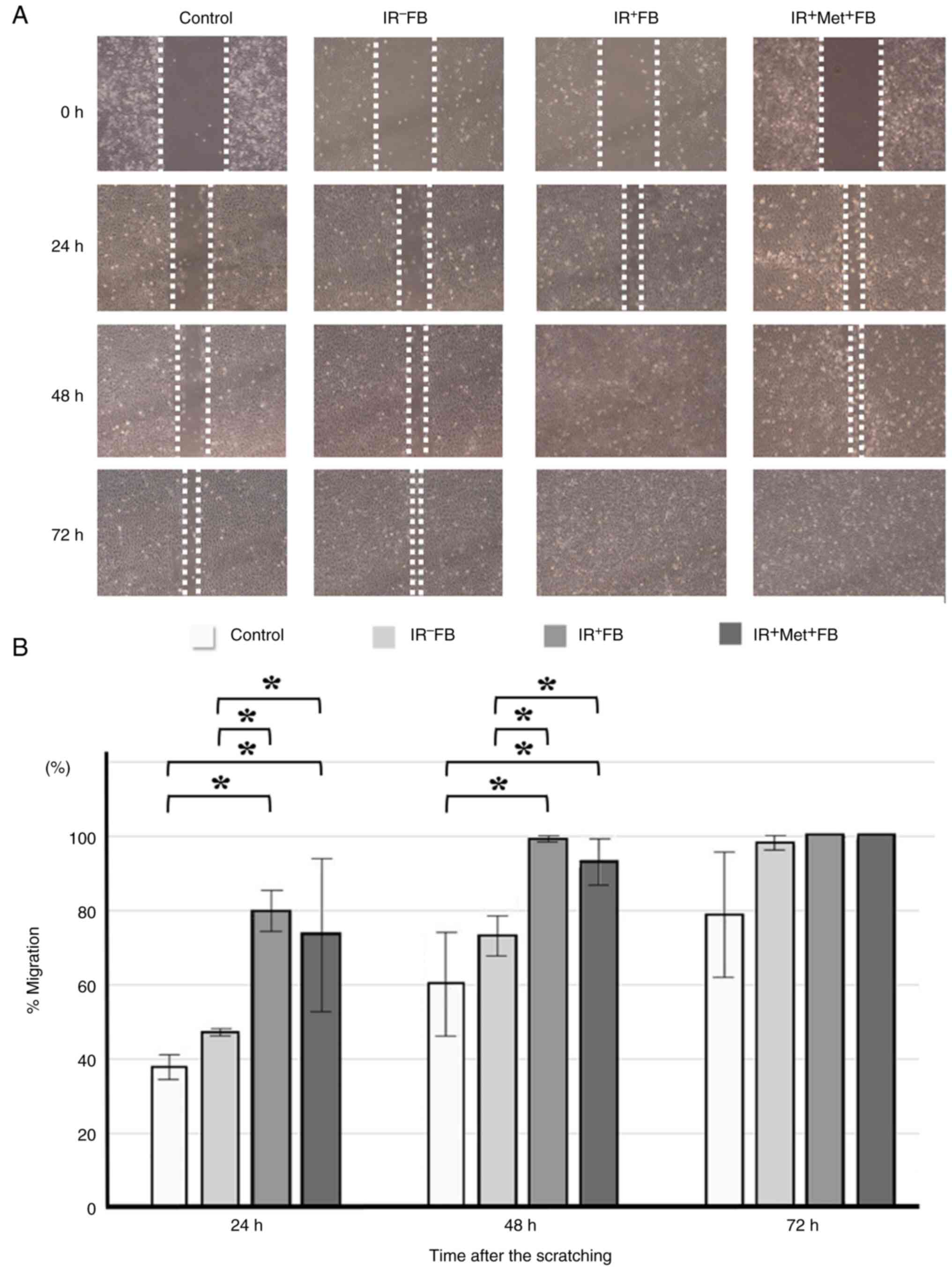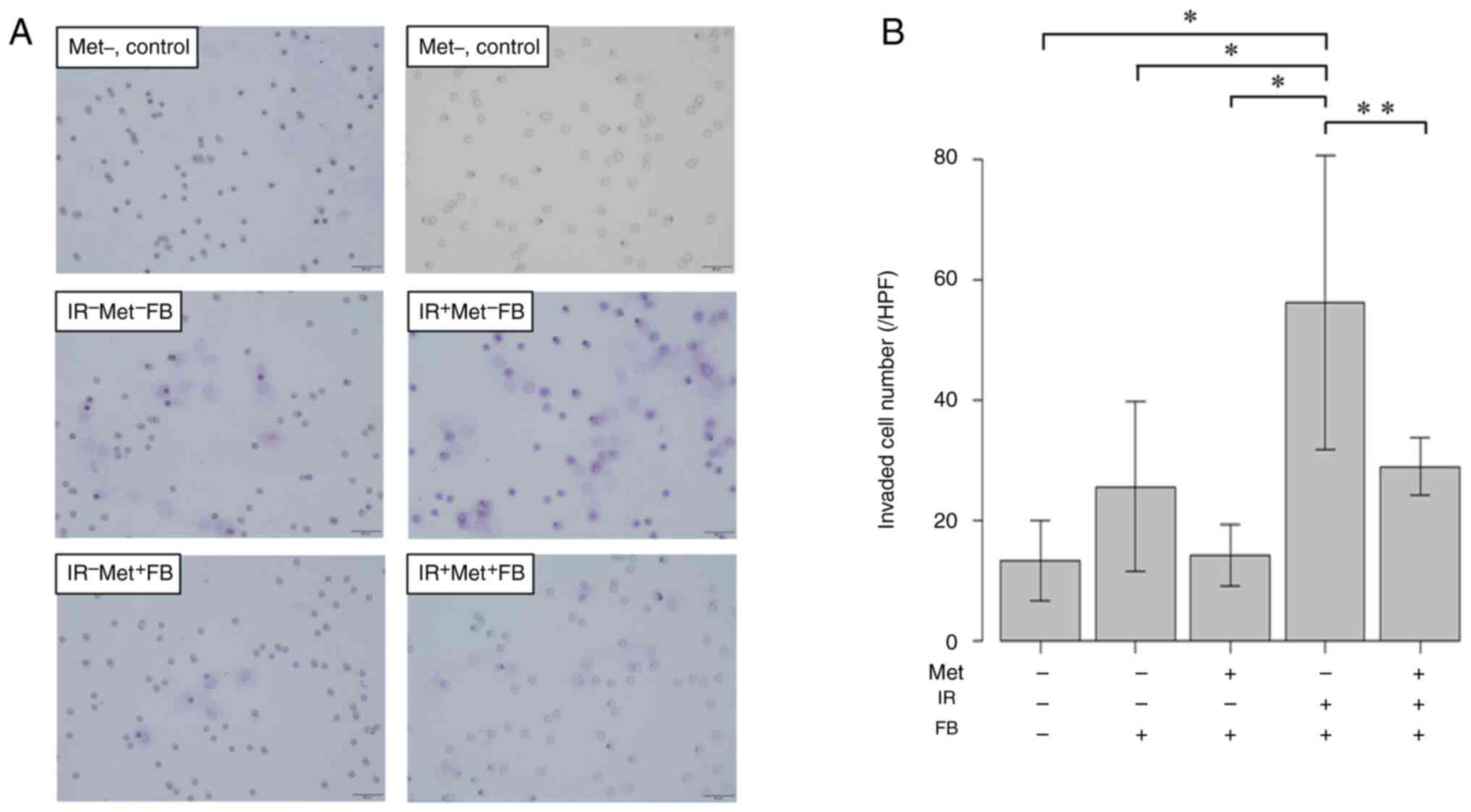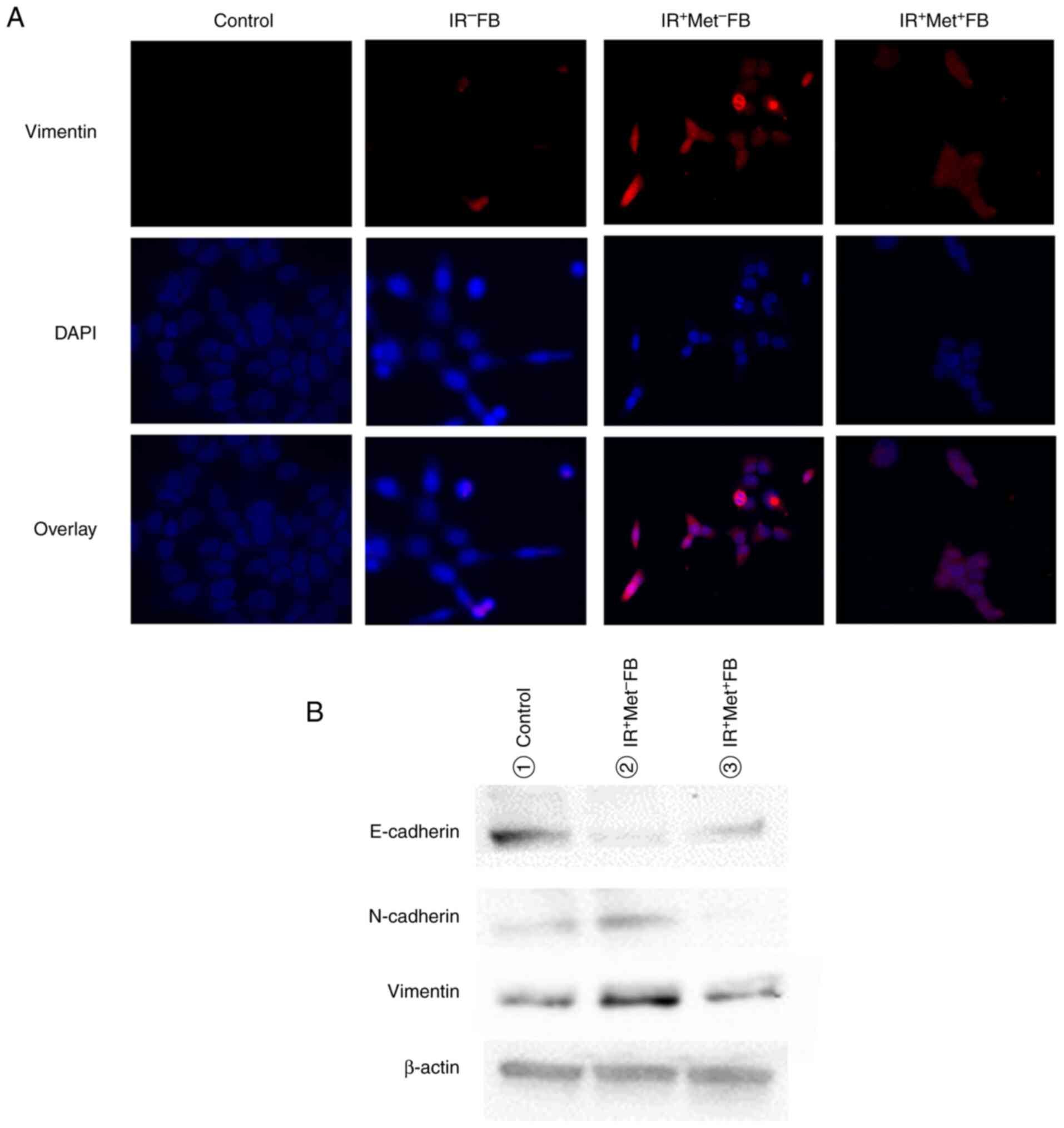Metformin suppresses esophageal cancer progression through the radiation‑induced cellular senescence of cancer‑associated fibroblasts
- Authors:
- Published online on: August 2, 2024 https://doi.org/10.3892/or.2024.8788
- Article Number: 129
-
Copyright: © Sugimoto et al. This is an open access article distributed under the terms of Creative Commons Attribution License.
Abstract
Introduction
Esophageal cancer, the sixth leading cause of cancer-related mortality worldwide, poses a significant health concern. Esophageal squamous cell carcinoma (ESCC) and esophageal adenocarcinoma, which are the two major subtypes of esophageal cancer, are epidemiologically and biologically distinct. ESCC is particularly prevalent in populous Asian regions with a weak alcohol reductase and acetaldehyde reductase expression, and accounts for ~90% of all esophageal cancer cases (1). Additionally, esophageal cancer is known to be one of the solid cancers with a very poor prognosis despite multidisciplinary treatment. This is due to malnutrition associated with the cancerous stenosis of the esophageal lumen, metastases to distant organs and lymph nodes, and its invasiveness to other organs around the esophagus (2).
In cases of esophageal cancer progression, not only cancer cells, but also the tumor microenvironment constructed from the extracellular matrix, fibroblasts, immune cells, blood vessels, cytokines and chemokines, and exosomes, are considered to play a critical role. Each of these factors greatly contributes to cancer cell proliferation, invasiveness and metastatic potential, and the fibrosis of the cancer stroma. In particular, investigating the roles and mechanisms of cancer-associated fibroblasts (CAFs), which are intratumoral fibroblasts, in the cancer microenvironment is necessary to elucidate the pathology and develop new therapeutic methods.
Cellular senescence has been reported to be involved in cancer growth and progression (3). Cellular senescence, along with apoptosis, is considered a major pathway of cancer suppression. The senescence-associated secretory phenotype (SASP), which indicates the secretion of inflammatory cytokines [interleukin (IL)-6, IL-1, IL-8, TNF-α, and INF-γ], chemokines [growth-regulated protein (GRO)-α, C-X-C motif chemokine ligand (CXCL), CC chemokine ligand], extracellular matrix remodeling factors [matrix metalloproteases (MMPs) and so on] and growth factors (hepatocyte growth factor, platelet-derived growth factor AA, fibroblast growth factor, epidermal growth factor and vesicular endothelial growth factor) secreted from senescent CAFs, is a key factor affecting the fibrosis of the cancer stroma, cancer a paracrine mechanism which induces migration and invasiveness in the epithelial mesenchyme, a hallmark of malignancy (1). Senescent stromal cells also secrete membrane cofactor protein, colony-stimulating factor, macrophage inflammatory protein, GRO and CXCL, and may have an amplification activation loop to replenish inflammatory and immune cells that also secrete pro-angiogenic factors (vascular endothelial growth factor, IL-8 and MMPs) (3). In fibroblasts surrounding ovarian cancer, the chemokine GRO-1 has been reported to induce fibroblast senescence via the RAS signaling pathway, which in turn contributes to ovarian tumorigenesis (4). SASP is among the homeostatic mechanisms inherent in cells to prevent carcinogenesis. In this phenomenon, cells undergo irreversible cell cycle arrest by DNA damage, such as telomere shortening and oncogene activation (5).
Unlike apoptosis, senescent cells are considered to survive for a long period of time without immediately dying. In the mechanism of tissue repair, progenitor cells and fibroblasts undergo cellular senescence in the body (6). The process of cellular senescence is as follows: Telomere shortening due to mitotic lifespan and accumulation of DNA damage due to external stress induce the activation of growth inhibitory factors, including the p53-p21 and p16 pathways. RB protein is constitutively activated by the induction of the CDK inhibitors, p21 and p16. RB protein activation inhibits the transcriptional activity of E2F, a transcription factor required for the transition from the G1 phase to the S phase, resulting in cell cycle arrest and cellular senescence. p16 binds to CDK4/6 and p21 binds to CDK2. This results in complete RB activation, which alone, is insufficient (7–9). Several factors alter the expression of genes encoding the SASP factors. In particular, C/EBPβ and NF-κB are considered major factors. Although cellular senescence is considered to be involved in tissue repair and immune cell migration, it is also considered to be involved in the promotion of carcinogenesis and the development of age-related diseases through the action of SASP (1).
Conversely, it has become clear that epithelial-mesenchymal transition (EMT) is involved in the metastasis and invasion of esophageal cancer (10). In the EMT process, epithelial cells lose their cell polarity and cell adhesion function with surrounding cells by responding to intracellular and extracellular signaling pathways (11). EMT is induced by several transcription factors and cytokines, including transforming growth factor-β (TGF-β) and cell growth factors, increasing the expression of these transcription factors and inducing EMT (12,13). These SASP-associated factors are considered to promote tumor growth by inducing EMT (3,14).
As a drug affecting SASP, rapamycin suppresses SASP expression by repressing NF-κB activation through the inhibition of IL-1α translation by mammalian target of rapamycin (mTOR)C1 (15). Additionally, metformin, which is used widely as an antidiabetic drug, has been reported to inhibit mTOR. The inhibition of the mTOR and Stat3 pathways by metformin suppresses the action of SASP (16).
Controlling the induction of SASP from senescent fibroblasts in cancer tissues suppresses the paracrine effects on cancer cells; however, the details of this mechanism remain unclear. The present study aimed to elucidate the in vitro SASP-mediated interactions between ESCC cells and radiation-induced senescent CAFs in the tumor microenvironment. Additionally, the present study aimed to determine the effect of preventing cancer progression through the regulation of SASP by drug repositioning using metformin.
Materials and methods
Ethics approval
The present study was approved by the Institutional Review Board of Kanazawa University (study no. 2016-463). Written informed consent was obtained from all patients for the use of surgically resected specimens.
Cell line and cell culture
The human ESCC cell line, KES, has been previously established in the authors' laboratory from endoscopic biopsy specimens obtained from a patient carrying a well-differentiated ESCC (17). KES cells were cultured in RPMI-1640 (Gibco; Thermo Fisher Scientific, Inc.) supplemented with 10% heat-inactivated fetal bovine serum (FBS; Nichirei Biosciences Inc.), 100 IU/ml penicillin, 100 µg/ml streptomycin (Thermo Fisher Scientific, Inc.), and 2-mM glutamine (Nissui Pharmaceutical Co. Ltd.) at 37°C with 5% CO2.
Establishment of the fibroblast cell line
Normal esophageal mucosae were collected from surgically resected specimens from patients with advanced-stage esophageal cancer. The fibroblasts were separated and cultured using the following method: i) Tissues were washed with serum-free DMEM (FUJIFILM Wako Pure Chemical) containing 200 µg/ml kanamycin (Meiji Seika Pharma Co., Ltd.) and 10 µg/ml amphotericin B (Bristol-Myers Squibb) three times; ii) tissues were cut into 3–5 mm square sections, which were placed on 200 µl BD Matrigel Matrix (BD Biosciences) in a 12-well plate; iii) to prevent the small tissues from moving in each well, the tissues were covered with a sterilized 15-mm round cover glass and cultured with DMEM containing 10% FBS (Gibco; Thermo Fisher Scientific, Inc.), 50 µg/ml kanamycin (Meiji Seika Pharma Co., Ltd.) and 2.5 µg/ml amphotericin B at 37°C in a humidified atmosphere; i) the medium was changed every other day until the tissues were surrounded by adherent fibroblasts; and v) when the fibroblasts reached 30–50% confluency, they were harvested with 0.25% trypsin and 1-mM EDTA and then re-plated in a T25 culture flask.
Reagents and antibodies
Metformin was purchased from FUJIFILM Wako Pure Chemical and was dissolved in phosphate-buffered saline at a stock concentration of 100 mM and stored at −20°C. The reagents and primary antibodies used are listed in Table I.
Irradiation of fibroblasts
Cultures were irradiated using an MBR-1520R-3 (Hitachi Medical Corporation), with a power output of 125 kV and 20 mA. Forward-scattered radiation with 0.5 mm Al and 0.2 mm Cu filters were used. Normal fibroblasts were irradiated with a single X-ray dose at 4, 8 and 10 Gy. In subsequent experiments, the fibroblasts irradiated with 8 Gy and cultured for 5–8 days (IR+FB) were used as senescent cells, and non-irradiated fibroblasts within 2–5 passages (IR−FB) were used as normal fibroblasts.
Assessment of cellular senescence in irradiated fibroblasts using SA-β-gal staining
SA-β-gal staining was used to count the number of senescent cells in each condition after 4, 8 and 10 days (Fig. S1). The cells were stained with SA-β-Gal using the senescence kit (OZ Bioscience) according to the manufacturer's protocol. The cells were incubated with staining solution at 37°C overnight, and SA-β-Gal-positive cells were counted. The number of dead and viable cells was measured using an EVE automatic cell counter (AR Brown Co., Ltd.). Using this result, the radiation dose and number of days after irradiation required for senescence were determined. A microscope (BX-50, Olympus Corporation) was used for cell observation.
The irradiated fibroblasts were supplemented with 5 mM metformin for the following defined periods: i) The control (no addition); and ii) 8 days after irradiation. A total of 5 mM metformin was added to the non-irradiated fibroblasts. In the irradiated fibroblast group, irradiation was performed at 72 h after fibroblast seeding. In each group, the number of surviving cells and percentage of cells positive for SA-β-gal staining at 11 days after seeding were determined.
Collection of fibroblast culture supernatant
IR+FB and IR−FB were each cultured in a confluent state in a six-well plate. The medium was replaced (RPMI-1640 + 10% FBS ± 5 mM metformin) and cultured at 37°C with 5% CO2 for 48 h. The medium was replaced with serum-free RPMI-1640 and cultured at 37°C with 5% CO2 for 24 h. The culture medium was recovered, centrifuged at a temperature of 4°C at 358.08 × g for 10 min, and the supernatants were obtained, which were as follows: i) IR−FB with metformin (IR−Met+FB); ii) IR−FB without metformin (IR−Met−FB); iii) IR+FB with metformin (IR+Met+FB); and iv) IR+FB without metformin (IR+Met−FB). The harvested culture supernatant was added to the KES cells and cell proliferation, migration and invasion, and the promotion of EMT were evaluated using immunocytochemistry, western blot analysis, cell proliferation assay, scratch wound assay and Matrigel invasion assay.
Immunocytochemistry
KES cells were cultured on Lab-Tec chamber slides (Nalge Nunc International Corporation). The cells were cultured in a serum-free medium for 24 h and then incubated with supernatant separated from the fibroblasts for 48 h. The cells were blocked with 1.5% bovine serum albumin and incubated with a mouse mono-clonal antibody against vimentin (sc-6260, 1:100 dilution; Santa Cruz Biotechnology Inc.) or a rabbit poly-clonal antibody against E-cadherin (sc-7870, 1:100 dilution; Santa Cruz Biotechnology, Inc.) and mouse monoclonal antibody against β-catenin (A5441, 1:100 dilution; Santa Cruz Biotechnology Inc.) overnight at a temperature of at 4°C. Immunoreactivity was visualized by incubating the cells with anti-rabbit IgG conjugated with Alexa Fluor 488 (A11008) or 594 (A11012) (Molecular Probes; Thermo Fisher Scientific, Inc.) for 1 h at 26°C. The cells were counterstained with bisbenzimide (Hoechst 33258, 100 ng/ml; MilliporeSigma) to visualize the nuclei. Finally, the cells were examined under an immunofluorescence microscope (BX50/BX-FLA, Olympus Corporation).
Western blot analysis
KES cells were cultured in a serum-free medium for 24 h and then incubated with supernatant separated from fibroblasts for 72 h. IR+FB and IR−FB were each cultured in a serum-free medium for 24 h and then incubated at 37°C with various concentrations (0–10 mM) of metformin for 5 days. First, cells were lysed in RIPA buffer (Wako Pure Chemical Industries, Ltd.) containing a protease and phosphatase inhibitor cocktail (MilliporeSigma). The protein concentration of each sample was measured using a BCA protein assay kit (Thermo Fisher Scientific, Inc.). The cell lysates were prepared in denatured sodium dodecyl sulfate (SDS) sample buffer and subjected to SDS-polyacrylamide gel electrophoresis. The proteins (20 µg) from each sample were loaded on a 10% polyacrylamide gel (Bio-Rad Laboratories, Inc.). The separated proteins were transferred to a polyvinylidene difluoride (PVDF) membrane (Bio-Rad Laboratories, Inc.) and blocked with a commercial gradient buffer (PVDF blocking reagent; Can Get Signal, Toyobo Life Science) for 1 h at 26°C. The membranes were incubated with the primary antibody overnight at 4°C. The primary antibodies used are listed in Table I. After washing, the membranes were incubated with horseradish peroxidase-labeled anti-mouse (NA931) or anti-rabbit IgG (NA934) (1:10,000 dilution; Cytiva) or anti-goat IgG (sc-2354, 1:10,000 dilution; Santa Cruz Biotechnology, Inc.) for 1 h at 26°C. Antibody-antigen complexes were detected using the ECL Plus Kit (Cytiva) and the Light Capture System (Atto Co., Ltd.). The intensity of the protein bands was quantified using ImageJ software ver 1.51k (National Institutes of Health).
Cell proliferation assay
The proliferation of fibroblasts or KES cell was determined using a 3-(4,5-dimethylthiazol-2-yl)-2,5-diphenyl tetrazolium bromide (MTT; MilliporeSigmah) assays. The cells were seeded in a 96-well culture plate at a density of 4×103 cells/200 µl/well and incubated for 24 h at 37°C to confirm cell colonization. In the experiments with fibroblasts, fibroblasts were treated with various concentrations (0.1–10 mM) of metformin for 48 and 72 h. In the experiments with KES cells, the KES cells were cultured in a serum-free medium for 24 h. The KES cells were then incubated with supernatants separated from the fibroblasts at various concentrations for 24, 48 and 72 h. The medium was removed and crystallized formazan dye in the cells was solubilized by addition of dimethyl sulfoxide. The absorbance was measured at 535 nm and the effect on cell proliferation in proportion to the control was investigated by comparing the cell density of the drug-treated cells with that of the untreated controls. In experiments with fibroblasts, the MTT assay was used to evaluate the toxicity of metformin on cells and to determine the metformin concentration to be used. All experiments were repeated at least three times.
Scratch wound assay
The scratch wound assay was used for the assessment of the migratory ability of the cancer cells. The KES cells were seeded in six-well plates at a density of 1.2×105 and incubated overnight at 37°C until reaching confluency (100%). The cells were scratched with a 1,000-µl pipette tip and washed twice with serum-free RPMI-1640 to remove the exfoliated cells. The medium was then replaced with the respective supernatants prepared. Wound closure rates were assessed and images were obtained after 24, 48, and 72 h. Each value was derived from three fixed points. A microscope (BX-50, Olympus Corporation) was used for cell observation.
Matrigel invasion assay
The Matrigel invasion assay was used to examine the invasiveness of the cancer cells. The KES cells were cultured in RPMI-1640 medium without FBS for 24 h. The cells were collected by trypsinization and resuspended in a serum-free medium at 1×105 cells/ml. Altogether, 2.5×104 KES cells were cultured in the upper chamber of a 24-well Transwell insert (Corning Life Sciences) that was coated with 50 µl Matrigel (1:10 dilution in serum-free medium; BD Biosciences). IR+FB or IR−FB with RPMI-1640 with or without 5 mM metformin were added to the lower chamber. The cells were incubated at 37°C for 24 h. The cells that migrated through the Matrigel and membranes with a pore size of 8 µm were fixed in 100% methanol (FUJIFILM Wako Pure Chemical) for 1 min, stained with by hematoxylin (FUJIFILM Wako Pure Chemical) for 2 min at 26°C and counted under an optical microscope (BX-50, Olympus Corporation). All experiments were carried out with three repetitions.
Statistical analysis
The data were analyzed using two-way ANOVA followed by the Bonferroni post hoc test, one-way ANOVA followed by Tukey's post hoc test, and repeated measures two-way ANOVA followed by the Bonferroni post hoc test as appropriate. The results are expressed as the mean ± standard deviation. All analyses were performed using SPSS software (IBM Statistics ver. 25; IBM Corp.). A value of P<0.05 was considered to indicate a statistically significant difference.
Results
Induction of cellular senescence of fibroblasts by radiation
Normal fibroblasts were exposed to various doses of radiation, and SA-β-gal staining was used over time to confirm whether cellular senescence occurred (Fig. S1). With 4 Gy irradiation, 50% of the cells were not stained in any time period. After 8 days of 8 Gy irradiation, >50% of the cells exhibited positivity for SA-β-gal staining (Fig. 1). In the subsequent experiments, fibroblasts that had been irradiated with 8 Gy for 5–8 days were used as senescent cells.
Cytotoxicity of metformin to fibroblasts
The present study examined the effects of metformin on the proliferation of fibroblasts using MTT assay. Metformin loading did not significantly inhibit cell proliferation at any concentration used, with or without irradiation (Fig. 2). Subsequent experiments were performed using a dilution of 5 mM metformin.
Effects of metformin on cellular senescence
The irradiation of fibroblasts was found to induce a decrease in the number of viable cells and cellular senescence. The treatment of irradiated fibroblasts with metformin decreased the number of viable cells to 57.3% (P=0.02) and increased the proportion of senescent cells to 68.4% (P<0.001) (Fig. 3).
Various concentrations of metformin were added to the irradiated fibroblasts and specific proteins were evaluated by performing western blot analysis. Loading higher metformin concentrations tended to suppress the expression of NF-κB, which is responsible for major signaling that stimulates the expression of SASP, whereas the expression of anti-p21, a senescence marker, was enhanced (Fig. 4).
Metformin suppresses irradiation-induced SASP secretion
The present study investigated the effects of SASP factors secreted by irradiated fibroblasts on cancer. The present study also investigated the effects of the addition of metformin to fibroblasts on SASP secretion. As illustrated in Fig. 5, Fig. 6, Fig. 7, Fig. 8, the esophageal cancer cells cultured with the supernatant obtained from the irradiated fibroblasts exhibited cell proliferation (Fig. 5), migratory ability (Fig. 6) and invasiveness (Fig. 7), and EMT was promoted (Fig. 8). When the fibroblasts were cultured in the supernatant from the irradiated fibroblasts pre-treated with metformin, there was no effect on the migratory ability of the cancer cells; however, the proliferative ability, invasiveness and EMT were confirmed to be suppressed.
Discussion
The aim of the present study was to clarify the role of SASP-mediated interactions between the ESCC cells and radiation-induced senescent CAFs and to examine the effects of preventing cancer progression through the regulation of SASP by metformin. In the present study, the irradiation of fibroblasts induced cellular senescence and subsequent SASP secretion. Moreover, metformin inhibited the radiation-induced cellular senescence and subsequent SASP in the cell lines and ESCC progression via the activation of EMT.
It is clinically important to perform chemotherapy or radiotherapy to control the primary lesions, metastasis, and circulating tumor cells in the blood to treat cancer and improve disease prognosis. Contrarily, in recent years, cellular senescence has attracted attention as a reaction induced by DNA damage that causes carcinogenesis, including the shortening of telomeres and activation of oncogenes, in contrast to apoptosis, which has long been known as a cancer-suppressing mechanism (7–9). In the SASP state, senescent cells secrete inflammatory cytokines, such as IL-6 and IL-1, chemokines, such as IL-8 and CXCL, and proteins, such as MMPs and various growth factors (1–3). Some fundamental studies have reported that SASP is deeply involved in cancer progression through the paracrine action in cancer tissues caused by SASP (1,2,18). Additionally, the administration of anticancer drugs or irradiation, which are major means of treatment for esophageal cancer, also causes cellular senescence in normal cells including fibroblasts in the host. Hernandez-Segura et al (19) reported that cellular senescence occurred in benign cells due to irradiation. This is considered to play a critical role in further cancer progression and the acquisition of treatment resistance.
The present study investigated whether cellular senescence occurs in fibroblasts isolated and cultured from resected human esophageal cancer tissues. A time-dependent increase was observed in the positive counts in SA-β gal staining following a single dose of radiation. Additionally, an expression of increased p16 and p21 was observed, which comprehensively supports the occurrence of cellular senescence in fibroblasts. In the experimental results presented in Fig. 4, p21 expression was not observed in fibroblasts at day 8 (data not shown) following irradiation; thus, those at day 5 following irradiation were used. The reason for this is that once activated, p16 and p21 are inactivated during the aging process (9), and the measurement on day 8 may have been made at a time when they were inactivated. Another possibility is that there may have been a procedural error.
The expression of Lys53 (Ac-p382) and acetylated p21 at p53 has been shown to be increased in hepatocellular carcinoma following treatment with metformin (20). Metformin also enhanced the expression of p21, a senescence marker in a concentration-dependent manner. Moreover, irradiation increased the expression of NF-κB in fibroblasts and induced the transcriptional enhancement of IL-1, IL-2, IL-6, IL-8, IL-12 and TNF-α, among others. The irradiation also promoted SASP-induced cytokine secretion (21). Contrarily, p53 functions suppressively in the induction of SASP and the upregulation of p16, and it has been reported that the expression of the F-box protein gene, known as FBXO22, is specifically induced among the genes specifically expressed in senescent cells (22).
Low-dose metformin also induces p53-dependent senescence in hepatoma cells by activating AMPK signaling (20). The data of the present study also suggested metformin-induced fibroblast senescence. Therefore, it was expected that the administration of metformin in addition to irradiation would further induce cellular senescence. However, the percentage of senescent cells increased, although the number of viable cells decreased. The present study was not able to examine in detail how metformin acts on the target cells. Studies to date have revealed a variety of effects of metformin. Metformin activates AMPK by increasing intracellular AMP concentrations (23). This acts on energy metabolism and inhibits cell proliferation. It has also been shown to inhibit the progression of the cell cycle from G1 to S phase by decreasing the level of cyclin D1 (24). It is considered that these factors contribute to the decreased survival rate.
Whether DNA damage induces apoptosis or cellular senescence is dependent on the amount of stress present. Excessive stress was considered to induce increased apoptosis beyond cellular senescence. Recently, several genes controlling these factors have been reported (25).
In the experimental results presented in Figs. 2 and 3, fibroblasts were used 5–8 days following irradiation and 72 h following treatment with metformin in the MTT assay as the cause of the difference in the number of viable cells. In the cell count experiment, metformin was administered for 8 days immediately following irradiation. Thus, the decrease in cell number may be due to spontaneous cell dropout over time or increased cell death due to excessive DNA stress from radiation and metformin. As a limitation, however, this hypothesis was not experimentally proven in the present study and is an issue for the future.
For controlling cancer, not only the proliferative activity of cancer cells themselves, but also the metastatic ability, invasiveness, fibrogenesis of cancer stroma, and overcoming treatment resistance are considered critical. The fibroblasts of the host are induced into the tumor tissue by microenvironment changes caused by growth factors and cytokines secreted by autocrine or paracrine manners from tumor cells and CAFs in and around the cancer stroma. Induced CAFs generate extracellular matrices, such as hyaluronic acid and collagen, which accelerate tumor growth and stromal fibrosis (26). SASP factors do not only promote tumor cell proliferation, but also have synergistic effects on the induction of EMT and stromal fibrosis. Okamoto et al (13) previously reported that the interaction between CAFs, including hepatic stellate cells and myofibroblasts, and cholangiocarcinoma cells promotes cancer cell proliferation and EMT through the function of angiotensin II, stromal derived factor-1 and TGF-β derived from activated CAFs, which is deeply involved in cancer progression, metastasis and the invasiveness of cholangiocarcinoma. Additionally, abnormally high levels of membrane type 1-MMP are often expressed in the tumor microenvironment. MMP has been reported to be highly expressed in senescent fibroblasts (27). Membrane type 1-MMP promotes the EMT of cancer cells by degrading the extracellular matrix, invading the surrounding tissue, and gaining the ability to form new blood vessels (28). Takino et al (29) demonstrated that MT1-MMP inhibited nascent fibronectin assembly by not only cleaving, it but also controlling the cell-matrix adhesions in the close proximity of cell-cell contacts, resulting in the reduction of N-cadherin adhesions and fibronectin matrix assembly. Nakayama et al (30) conducted fundamental research on radiation-induced EMT in ESCC cells and the EMT inhibitory effect of metformin through TGF-β regulation (30). The present study demonstrated that the addition of supernatant from irradiated fibroblasts to KES cells significantly increased the cancer cell proliferation, invasive and migratory abilities, and EMT marker activation. This result supports the findings that CAF-derived inflammatory cytokines and chemokines in the SASP state-induced EMT and the CAF-mediated paracrine action synergistically have a significant effect on cancer cell activation (14). In the experimental results presented in Fig. 7, the results of Matrigel assay revealed the promotion of cancer cell invasion by irradiated fibroblasts and its suppression by metformin. However, there was a large variation in the number of invading cells in the IR+Met−FB group. The possible reasons for this event were that the cancer cells did not adhere uniformly or were not distributed uniformly due to a partial lack of Matrigel.
In solid malignant tumors, the fibrous tissue development in the cancer stroma inhibits the development of peripheral blood vessels and the distribution of anticancer drugs to the cancer cells, which can be among the causes of anticancer drug resistance. To the best of our knowledge, there has been no basic research on the mechanisms of cancer progression, fibrosis and treatment resistance through cellular senescence in fibroblasts coexisting in cancer tissues, and their influence on the cancer microenvironment via SASP in esophageal cancer, which is among the refractory solid tumors.
Metformin exerts antitumor effects by inhibiting mTORC1 through AMPK activation (31). Metformin also inhibits NF-κB via mTOR (32). Additionally, metformin inhibits ROS production in senescent cells (33), and mitochondrial reactive oxygen species are involved in NF-κB activation (34,35). Metformin inhibits IKKα/β kinases, but not p38 MAPK. Since these pathways are downstream of TGF-β-activated kinase 1 (TAK1), they are considered to interfere only with the IKK activation pathway. In addition, in a previous study, qPCR analysis confirmed that the expression of multiple cytokines and chemokines, such as CXCL5, IL-1b, IL-6 and IL-8, was inhibited (16).
Several factors have been reported to alter the expression of genes encoding SASP factors in the molecular mechanisms involved in induction. The present study focused on NF-κB, which is considered to be a major factor, with the aim of regulating SASP in senescent fibroblasts. NF-κB is a transcription factor that regulates the gene expression of chemokines that bind to CXCR2 (18). Cellular senescence signals phosphorylate p65 and translocate the p65/p50 complex (NF-κB) into the nucleus. As a result, the p65 subunit of NF-κB functions as a transcription factor by binding to the transcriptional regulatory region of the SASP gene (36). mTOR is involved in regulating NF-kB. mTOR positively regulates SASP gene expression through the NF-KB pathway by promoting IL-1a translation (37). IL-1a is a master regulator that acts upstream of many SASP factors, including IL-6 and IL-8. Furthermore, SASP factors induced by IL-1a expression exhibit paracrine effects on the surrounding cells and induce cellular senescence (38,39). In the present study, mTORC1 was hypothesized to inhibit metformin-suppressed SASP, resulting in an antitumor effect. However, the present study did not examine the secretion of SASP, such as IL-6. Further studies are thus required to elucidate this matter.
Clinical studies have reported several beneficial effects of metformin in the treatment of cancer. A previous retrospective study demonstrated that patients with type 2 diabetes taking metformin for >4 years had a significantly lower incidence of cancer than patients receiving other diabetes treatments (40). Additionally, metformin increases the pathological response rate following neoadjuvant chemotherapy for breast cancer in diabetic patients (41). In another study, the administration of metformin to patients who had undergone surgery for early-stage colorectal cancer reduced the cancer recurrence by 37% and increased the survival rate by 31% (42). Metformin use also reduced the risk of mortality in patients with pancreatic cancer by 12%. The effect was particularly large in patients with stage I or II cancer detected at a relatively early stage, and the risk of mortality decreased by 26% (43). All these effects may have been the result of antitumor effects, as the secondary effects of metformin may have reflected the effect of the drug's rearrangement on the cancer cells themselves and their microenvironment.
The present study has some limitations. First, the majority of in vitro studies investigating the anticancer effects of metformin have used metformin at concentrations of 1–10 mM (165–1,650 mg/l), which are well below therapeutic plasma levels (0.465–2.5 mg/l or 2.8–15 µM) (44). The present study utilized a high dose of metformin relative to the therapeutic plasma level of 5 mM. Second, the present study ensured the prevention of the direct effects of metformin on cancer cells by avoiding the exposure of ESCC cells to metformin. However, the possibility that metformin remained in the supernatant and directly affected cancer cells cannot be denied and the serum concentration of metformin will affect both fibroblasts and cancer cells in vivo. The authors deemed that this experimental environment was close to the actual condition in vivo. Third, no in vivo experiments were performed herein. This is necessary for clinical application and is an issue to be addressed in the future. Finally, the present study demonstrated only the radiation-induced cellular senescence of fibroblasts and events resulting in the paracrine-style activation of SASP factors secreted from them against cancer cells. The detailed composition of the SASP factors and the role of each factor were shown in the present study, and these are worthy of investigation in the future. To date, reports on this mechanism of cancer cell activation in esophageal cancer are limited (45,46), and the present study is a preliminary experiment for further research and the results may prove useful as a mechanism of cancer progression.
In conclusion, the present study demonstrated that the radiation-induced cellular senescence of CAFs and subsequent SASP secretion induced an increase in cell proliferation, migratory and invasive activities, and EMT in cancer cells. Moreover, metformin is expected to be effective as a chemical modulator and a therapeutic agent of esophageal cancer that targets cellular senescence and SASP through a novel mechanism. The antitumor effect by suppressing radiation-induced SASP is expected to be very promising in future anticancer therapy as a drug repositioning.
Supplementary Material
Supporting Data
Acknowledgements
The authors are grateful to Futakuchi and Yoshida, the Medical Technologist of Gastrointestinal Surgery, Kanazawa University, who provided technical support for the experiments and made significant contributions.
Funding
The present study was supported by Grants-in-Aid for Scientific Research from the Japan Society for the Promotion of Science (Grant no. 18K15627).
Availability of data and materials
The datasets used and/or analyzed during the current study are available from the corresponding author on reasonable request.
Authors' contributions
YS, KO, IN, TO and NI contributed to the conception and design of the study. KO and NI were supervised the work. YS collected data. YS and KO drafted the manuscript. KO, HS, TY, JK, KN, IN and NI surgically resected the specimens, which were used in the separation and culture of the fibroblasts. TT and YE contributed to establishing the fibroblasts and the analysis of the data. TT, TO and NI contributed to the editing and reviewing of the manuscript. YS and KO confirm the authenticity of all raw data. All authors have read and approved the final manuscript.
Ethics approval and consent to participate
The present study was approved by the Institutional Review Board of Kanazawa University (study no. 2016-463). Written informed consent was obtained from all patients for the use of surgically resected specimens.
Patient consent for publication
Not applicable.
Competing interests
The authors declare that they have no competing interests.
Glossary
Abbreviations
Abbreviations:
|
SASP |
senescence-associated secretory phenotype |
|
ESCC |
esophageal squamous cell carcinoma |
|
CAFs |
cancer-associated fibroblasts |
|
IL |
interleukin |
|
GRO |
growth-related oncogene |
|
CXCL |
C-X-C motif chemokine ligand |
|
MMPs |
matrix metalloproteases |
|
EMT |
epithelial-mesenchymal transition |
|
TGF-β |
transforming growth factor-β |
|
TOR |
target of rapamycin |
|
FBS |
fetal bovine serum |
|
SDS |
sodium dodecyl sulfate |
|
PVDF |
polyvinylidene difluoride |
References
|
Coppé JP, Patil CK, Rodier F, Sun Y, Muñoz DP, Goldstein J, Nelson PS, Desprez PY and Campisi J: Senescence-associated secretory phenotypes reveal cell-nonautonomous functions of oncogenic RAS and the p53 tumor suppressor. PLoS Biol. 6:2853–2868. 2008. View Article : Google Scholar : PubMed/NCBI | |
|
Kuilman T, Michaloglou C, Vredeveld LC, Douma S, van Doorn R, Desmet CJ, Aarden LA, Mooi WJ and Peeper DS: Oncogene-induced senescence relayed by an interleukin-dependent inflammatory network. Cell. 133:1019–1031. 2008. View Article : Google Scholar : PubMed/NCBI | |
|
Coppé JP, Desprez PY, Krtolica A and Campisi J: The senescence-associated secretory phenotype: The dark side of tumor suppression. Ann Rev Pathol. 5:99–118. 2010. View Article : Google Scholar : PubMed/NCBI | |
|
Yang G, Rosen DG, Zhang Z, Bast RC Jr, Mills GB, Colacino JA, Mercado-Uribe I and Liu J: The chemokine growth-regulated oncogene 1 (Gro-1) links RAS signaling to the senescence of stromal fibroblasts and ovarian tumorigenesis. Proc Natl Acad Sci USA. 103:16472–16477. 2006. View Article : Google Scholar : PubMed/NCBI | |
|
Serrano M and Blasco MA: Putting the stress on senescence. Curr Opin Cell Biol. 13:748–753. 2001. View Article : Google Scholar : PubMed/NCBI | |
|
Inomata K, Aoto T, Binh NT, Okamoto N, Tanimura S, Wakayama T, Iseki S, Hara E, Masunaga T, Shimizu H and Nishimura EK: Genotoxic stress abrogates renewal of melanocyte stem cells by triggering their differentiation. Cell. 137:1088–1099. 2009. View Article : Google Scholar : PubMed/NCBI | |
|
Serrano M, Lin AW, McCurrach ME, Beach D and Lowe SW: Oncogenic ras provokes premature cell senescence associated with accumulation of p53 and p16INK4a. Cell. 88:593–602. 1997. View Article : Google Scholar : PubMed/NCBI | |
|
Collado M, Blasco MA and Serrano M: Cellular senescence in cancer and aging. Cell. 130:223–233. 2007. View Article : Google Scholar : PubMed/NCBI | |
|
Childs BG, Durik M, Baker DJ and van Deursen JM: Cellular senescence in aging and age-related disease: From mechanisms to therapy. Nat Med. 21:1424–1435. 2015. View Article : Google Scholar : PubMed/NCBI | |
|
Isohata N, Aoyagi K, Mabuchi T, Daiko H, Fukaya M, Ohta H, Ogawa K, Yoshida T and Sasaki H: Hedgehog and epithelial-mesenchymal transition signaling in normal and malignant epithelial cells of the esophagus. Int J Cancer. 125:1212–1221. 2009. View Article : Google Scholar : PubMed/NCBI | |
|
Thiery JP, Acloque H, Huang RYJ and Nieto MA: Epithelial-mesenchymal transitions in development and disease. Cell. 139:871–890. 2009. View Article : Google Scholar : PubMed/NCBI | |
|
Xu J, Lamouille S and Derynck R: TGF-beta-induced epithelial to mesenchymal transition. Cell Res. 19:156–172. 2009. View Article : Google Scholar : PubMed/NCBI | |
|
Okamoto K, Tajima H, Nakanuma S, Sakai S, Makino I, Kinoshita J, Hayashi H, Nakamura K, Oyama K, Nakagawara H, et al: Angiotensin II enhances epithelial-to-mesenchymal transition through the interaction between activated hepatic stellate cells and the stromal cell-derived factor-1/CXCR4 axis in intrahepatic cholangiocarcinoma. Int J Oncol. 41:573–582. 2012. View Article : Google Scholar : PubMed/NCBI | |
|
Laberge RM, Awad P, Campisi J and Desprez PY: Epithelial-mesenchymal transition induced by senescent fibroblasts. Cancer Microenviron. 5:39–44. 2012. View Article : Google Scholar : PubMed/NCBI | |
|
Velarde MC, Demaria M and Campisi J: Senescent cells and their secretory phenotype as targets for cancer therapy. Interdiscip Top Gerontol. 38:17–27. 2013.PubMed/NCBI | |
|
Moiseeva O, Deschênes-Simard X, St-Germain E, Igelmann S, Huot G, Cadar AE, Bourdeau V, Pollak MN and Ferbeyre G: Metformin inhibits the senescence-associated secretory phenotype by interfering with IKK/NF-κB activation. Aging Cell. 12:489–498. 2013. View Article : Google Scholar : PubMed/NCBI | |
|
Makita N, Ninomiya I, Tsukada T, Okamoto K, Harada S, Nakanuma S, Sakai S, Makino I, Kinoshita J, Hayashi H, et al: Inhibitory effects of valproic acid in DNA double-strand break repair after irradiation in esophageal squamous carcinoma cells. Oncol Rep. 34:1185–1192. 2015. View Article : Google Scholar : PubMed/NCBI | |
|
Acosta JC, O'Loghlen A, Banito A, Guijarro MV, Augert A, Raguz S, Fumagalli M, Da Costa M, Brown C, Popov N, et al: Chemokine signaling via the CXCR2 receptor reinforces senescence. Cell. 133:1006–1018. 2008. View Article : Google Scholar : PubMed/NCBI | |
|
Hernandez-Segura A, Brandenburg S and Demaria M: Induction and validation of cellular senescence in primary human cells. J Vis Exp. 2018:e577822018.PubMed/NCBI | |
|
Yi G, He Z, Zhou X, Xian L, Yuan T, Jia X, Hong J, He L and Liu J: Low concentration of metformin induces a p53-dependent senescence in hepatoma cells via activation of the AMPK pathway. Int J Oncol. 43:1503–1510. 2013. View Article : Google Scholar : PubMed/NCBI | |
|
Hellweg CE, Spitta LF, Koch K, Chishti AA, Henschenmacher B, Diegeler S, Konda B, Feles S, Schmitz C, Berger T and Baumstark-Khan C: The role of the nuclear factor κB pathway in the cellular response to low and high linear energy transfer radiation. Int J Mol Sci. 19:22202018. View Article : Google Scholar : PubMed/NCBI | |
|
Johmura Y, Sun J, Kitagawa K, Nakanishi K, Kuno T, Naiki-Ito A, Sawada Y, Miyamoto T, Okabe A, Aburatani H, et al: SCF(Fbxo22)-KDM4A targets methylated p53 for degradation and regulates senescence. Nat Commun. 7:105742016. View Article : Google Scholar : PubMed/NCBI | |
|
Zakikhani M, Dowling R, Fantus IG, Sonenberg N and Pollak M: Metformin is an AMP kinase-dependent growth inhibitor for breast cancer cells. Cancer Res. 66:10269–10273. 2006. View Article : Google Scholar : PubMed/NCBI | |
|
Ben Sahra I, Laurent K, Loubat A, Giorgetti-Peraldi S, Colosetti P, Auberger P, Tanti JF, Le Marchand-Brustel Y and Bost F: The antidiabetic drug metformin exerts an antitumoral effect in vitro and in vivo through a decrease of cyclin D1 level. Oncogene. 27:3576–3586. 2008. View Article : Google Scholar : PubMed/NCBI | |
|
Nagano T, Nakano M, Nakashima A, Onishi K, Yamao S, Enari M, Kikkawa U and Kamada S: Identification of cellular senescence-specific genes by comparative transcriptomics. Sci Rep. 6:317582016. View Article : Google Scholar : PubMed/NCBI | |
|
Kalluri R: The biology and function of fibroblasts in cancer. Nat Rev Cancer. 16:582–598. 2016. View Article : Google Scholar : PubMed/NCBI | |
|
Ezure T, Sugahara M and Amano S: Senescent dermal fibroblasts negatively influence fibroblast extracellular matrix-related gene expression partly via secretion of complement factor D. Biofactors. 45:556–562. 2019. View Article : Google Scholar : PubMed/NCBI | |
|
Chun TH, Sabeh F, Ota I, Murphy H, McDonagh KT, Holmbeck K, Birkedal-Hansen H, Allen ED and Weiss SJ: MT1-MMP-dependent neovessel formation within the confines of the three-dimensional extracellular matrix. J Cell Biol. 167:757–767. 2004. View Article : Google Scholar : PubMed/NCBI | |
|
Takino T, Yoshimoto T, Nakada M, Li Z, Domoto T, Kawashiri S and Sato H: Membrane-type 1 matrix metalloproteinase regulates fibronectin assembly and N-cadherin adhesion. Biochem Biophys Res Commun. 450:1016–1020. 2014. View Article : Google Scholar : PubMed/NCBI | |
|
Nakayama A, Ninomiya I, Harada S, Tsukada T, Okamoto K, Nakanuma S, Sakai S, Makino I, Kinoshita J, Hayashi H, et al: Metformin inhibits the radiation-induced invasive phenotype of esophageal squamous cell carcinoma. Int J Oncol. 49:1890–1898. 2016. View Article : Google Scholar : PubMed/NCBI | |
|
Gonzalez-Angulo AM and Meric-Bernstam F: Metformin: A therapeutic opportunity in breast cancer. Clin Cancer Res. 16:1695–1700. 2010. View Article : Google Scholar : PubMed/NCBI | |
|
Lee SY, Moon SJ, Kim EK, Seo HB, Yang EJ, Son HJ, Kim JK, Min JK, Park SH and Cho ML: Metformin suppresses systemic autoimmunity in roquinsan/san mice through inhibiting b cell differentiation into plasma cells via regulation of AMPK/mTOR/STAT3. J Immunol. 198:2661–2670. 2017. View Article : Google Scholar : PubMed/NCBI | |
|
Algire C, Moiseeva O, Deschênes-Simard X, Amrein L, Petruccelli L, Birman E, Viollet B, Ferbeyre G and Pollak MN: Metformin reduces endogenous reactive oxygen species and associated DNA damage. Cancer Prev Res (Phila). 5:536–543. 2012. View Article : Google Scholar : PubMed/NCBI | |
|
Formentini L, Sánchez-Aragó M, Sánchez-Cenizo L and Cuezva JM: The mitochondrial ATPase inhibitory factor 1 triggers a ROS-mediated retrograde prosurvival and proliferative response. Mol Cell. 45:731–742. 2012. View Article : Google Scholar : PubMed/NCBI | |
|
Schreck R, Rieber P and Baeuerle PA: Reactive oxygen intermediates as apparently widely used messengers in the activation of the NF-kappa B transcription factor and HIV-1. EMBO J. 10:2247–2258. 1991. View Article : Google Scholar : PubMed/NCBI | |
|
Chien Y, Scuoppo C, Wang X, Fang X, Balgley B, Bolden JE, Premsrirut P, Luo W, Chicas A, Lee CS, et al: Control of the senescence-associated secretory phenotype by NF-κB promotes senescence and enhances chemosensitivity. Genes Dev. 25:2125–2136. 2011. View Article : Google Scholar : PubMed/NCBI | |
|
Laberge RM, Sun Y, Orjalo AV, Patil CK, Freund A, Zhou L, Curran SC, Davalos AR, Wilson-Edell KA, Liu S, et al: MTOR regulates the pro-tumorigenic senescence-associated secretory phenotype by promoting IL1A translation. Nat Cell Biol. 17:1049–1061. 2015. View Article : Google Scholar : PubMed/NCBI | |
|
Orjalo AV, Bhaumik D, Gengler BK, Scott GK and Campisi J: Cell surface-bound IL-1alpha is an upstream regulator of the senescence-associated IL-6/IL-8 cytokine network. Proc Natl Acad Sci USA. 106:17031–17036. 2009. View Article : Google Scholar : PubMed/NCBI | |
|
Acosta JC, Banito A, Wuestefeld T, Georgilis A, Janich P, Morton JP, Athineos D, Kang TW, Lasitschka F, Andrulis M, et al: A complex secretory program orchestrated by the inflammasome controls paracrine senescence. Nat Cell Biol. 15:978–990. 2013. View Article : Google Scholar : PubMed/NCBI | |
|
Evans JMM, Donnelly LA, Emslie-Smith AM, Alessi DR and Morris AD: Metformin and reduced risk of cancer in diabetic patients. BMJ. 330:1304–1305. 2005. View Article : Google Scholar : PubMed/NCBI | |
|
Jiralerspong S, Palla SL, Giordano SH, Meric-Bernstam F, Liedtke C, Barnett CM, Hsu L, Hung MC, Hortobagyi GN and Gonzalez-Angulo AM: Metformin and pathologic complete responses to neoadjuvant chemotherapy in diabetic patients with breast cancer. J Clin Oncol. 27:3297–3302. 2009. View Article : Google Scholar : PubMed/NCBI | |
|
Coyle C, Cafferty FH, Vale C and Langley RE: Metformin as an adjuvant treatment for cancer: A systematic review and meta-analysis. Ann Oncol. 27:2184–2195. 2016. View Article : Google Scholar : PubMed/NCBI | |
|
Wan G, Sun X, Li F, Wang X, Li C, Li H, Yu X and Cao F: Survival benefit of metformin adjuvant treatment for pancreatic cancer patients: A systematic review and meta-analysis. Cell Physiol Biochem. 49:837–847. 2018. View Article : Google Scholar : PubMed/NCBI | |
|
Dowling RJ, Niraula S, Stambolic V and Goodwin PJ: Metformin in cancer: Translational challenges. J Mol Endocrinol. 48:R31–R43. 2012. View Article : Google Scholar : PubMed/NCBI | |
|
Zhang JW, Zhang D, Yin HS, Zhang H, Hong KQ, Yuan JP and Yu BP: Fusobacterium nucleatum promotes esophageal squamous cell carcinoma progression and chemoresistance by enhancing the secretion of chemotherapy-induced senescence-associated secretory phenotype via activation of DNA damage response pathway. Gut Microbes. 15:21978362023. View Article : Google Scholar : PubMed/NCBI | |
|
Wang P, Lv C, Zhang T, Liu J, Yang J, Guan F and Hong T: FOXQ1 regulates senescence-associated inflammation via activation of SIRT1 expression. Cell Death Dis. 8:e29462017. View Article : Google Scholar : PubMed/NCBI |



